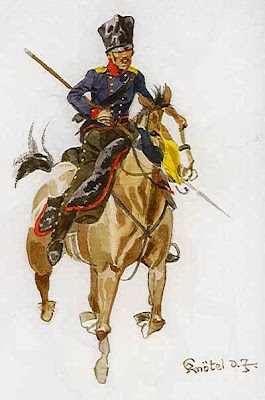With the
Grunberg Scenario under way (it is finished actually, but
the final result is under embargo until published!) I am 'researching' for the Christmas Lasalle battle. This time, the Scenario will be located in the
days following the battle of the Katzbach, when the
routed French forces were closely pursued by the
Prusso-Russian forces.
While preparing the OOB's for the Scenario, I found that the
Brandenburg Uhlans took part in the pursuit, but also that
there are not Prussian Uhlans amongst my lead/plastics recruits. Therefore, this will be the next painting project, really a very reduced one, because I only need 8 figures to build a four-bases 'normal' Lasalle unit.
A quick review of the literature, led to the classic
Osprey Men-at-Arms 172 book Prussian Cavalry of the Napoleonic Wars (2).1807–15, from
Peter Hofschröer and illustrated by
Bryan Fosten, where the uniforms are described.
Uhlans wore a
dark blue 'kollet' (a hip-length double-breasted tunic) with
poppy red collars and 'polish' (pointed) cuffs and two rows of buttons curveing slightly outwards to the top. The
lapels were piped in red and the short tails had a two-inch-wide red trim. The button colours and soulder straps were used to distinguish the regiment, with the
Brandeburg Uhlans (Regiment no. 3) carrying
yellow shoulder straps and buttons. The rank-and-fie could also wore a dark-blue Litewka (a long coat). A
dark blue sash piped in
red was carried by the rank-and-file The legwears were
dark-grey overalls covered in black leather up the whole length of the inner legs and around the ankles. Down the outer surface was an open seam closed with a row of buttons (piped in red?). They wore also a cavalry shako covered in campaign with a
black waxed cloth.
The armament consisted in a curved sabre with a steel scabbard. The troopers carried a lance with a
brown shaft and iron point. In 1813 the pennants were
dark blue on the lower halves and
yellow (Brandenburg Uhlans) on the upper half. The rankers wore also a pistol and a
black leather cartridge-box with white (shown black in all the sources) belt.
The horse furniture was a
black sheepskin saddle cloth with a
red 'wolf's teeth' (triangular) trim.
 |
| Taken from Elting & Knoetel |
The next step is to search for the adequate figures.















.JPG)



































































